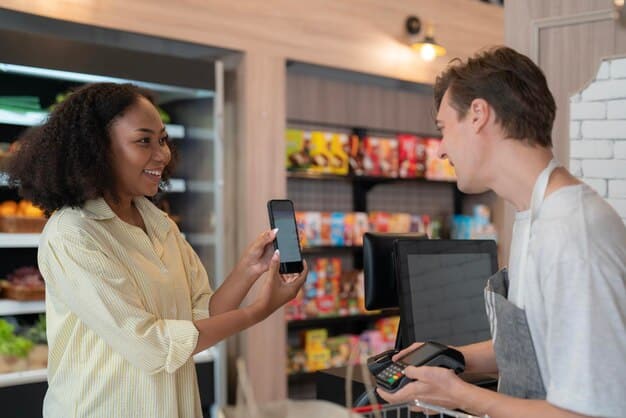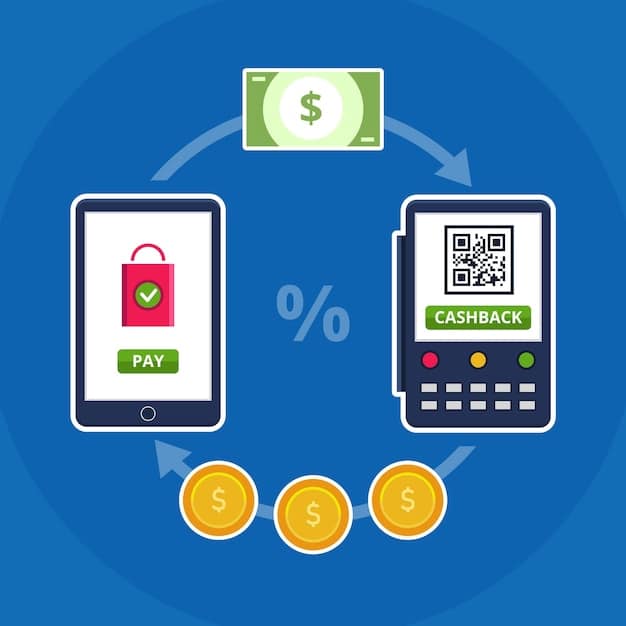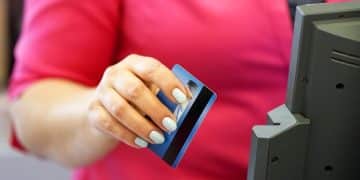QR Code Payments in the US: Risks, Rewards, and How-To Guide

Understanding the Risks and Rewards of Accepting QR Code Payments in Your US Store involves weighing the convenience and efficiency of these payments against potential security concerns and implementation costs, ultimately enhancing customer experience and potentially boosting sales.
Accepting QR code payments in your store can seem like navigating a new frontier, but **understanding the risks and rewards of accepting QR Code payments in your US store** is crucial for staying competitive and meeting customer expectations in today’s digital age.
What are QR Code Payments and How Do They Work?
QR code payments are a type of contactless payment method where customers use their smartphones to scan a QR code displayed by the merchant. This technology allows for quick and easy transactions, eliminating the need for physical cards or cash.
The process is straightforward. A customer opens a QR code scanning app, such as their mobile banking app or a dedicated payment app like PayPal or Venmo. They then scan the QR code presented by the store. This action initiates a payment request on their phone, and after confirming the amount, the transaction is completed almost instantly.

This method is gaining popularity due to its convenience and speed, offering a seamless shopping experience. But how exactly do QR codes facilitate these transactions?
The Technology Behind QR Code Payments
QR codes, or Quick Response codes, are two-dimensional barcodes that can store a variety of information, including payment details. When a customer scans a QR code, their smartphone decodes this information and uses it to initiate a transaction through a connected payment app.
These codes can be either static or dynamic. Static QR codes contain fixed payment information and are typically used for smaller transactions, while dynamic QR codes generate a unique code for each transaction, enhancing security.
- Convenience for Customers: Customers can pay quickly without needing to carry cash or cards.
- Efficiency for Merchants: Transactions are faster, reducing wait times and improving customer flow.
- Contactless Nature: Reduces physical contact, making it a safer option, especially in health-conscious times.
QR code payments represent a significant shift in how transactions are conducted, offering benefits to both consumers and businesses. Understanding this technology is the first step in evaluating its potential for your US store.
Advantages of Accepting QR Code Payments
Adopting QR code payments can bring numerous advantages to your business. Beyond the convenience factor, there are several financial and operational benefits to consider.
One of the primary advantages is the reduced transaction costs compared to traditional credit card payments. Because QR code payments often bypass traditional card networks, merchants can avoid hefty processing fees. This can significantly increase your profit margins over time.
Let’s delve deeper into specific benefits…

Lower Transaction Fees
Traditional credit card processing fees can eat into your profits. QR code payments, however, often come with significantly lower fees. This reduction in costs can make a big difference, especially for small businesses with tight margins.
The cost savings are primarily due to the direct transfer of funds between the customer and the merchant, eliminating the need for intermediaries that typically charge fees per transaction. Over time, these savings can accumulate and contribute to your bottom line.
Enhanced Customer Experience
In today’s fast-paced world, customers appreciate quick and convenient payment options. QR code payments provide a seamless and efficient way for customers to complete their purchases. This improved shopping experience can lead to increased customer satisfaction and loyalty.
Customers can simply scan and pay, reducing wait times and streamlining the checkout process. This can be particularly beneficial during peak hours when long lines can deter customers.
- Faster Transactions: Quick payments improve customer flow and reduce wait times.
- Convenient Payment Option: Customers appreciate having a variety of payment choices.
- Modern Appeal: Adopting new technologies can enhance your store’s image.
The financial and customer-centric benefits make a compelling case for integrating QR code payments into your US store. However, it’s crucial to also consider the potential risks involved.
Potential Risks and Challenges
While accepting QR code payments offers numerous benefits, it’s important to be aware of the potential risks and challenges that come with this payment method. Being prepared for these challenges can help you mitigate them effectively.
One significant risk is security. Like any digital payment system, QR code payments are susceptible to fraud and hacking. Ensuring that your systems are secure and educating your customers about safe practices is crucial.
Security Risks
One of the primary concerns is the potential for QR codes to be tampered with or replaced with malicious codes. These fraudulent codes can redirect customers to fake payment pages or install malware on their devices, compromising their personal and financial information.
Therefore, it’s essential to implement security measures such as regularly inspecting QR codes for any signs of tampering, using dynamic QR codes that expire after each transaction, and educating your staff and customers about the risks involved.
Adoption and Acceptance
Another challenge is ensuring that your target customers are ready to adopt this payment method. While QR code payments are becoming increasingly popular, not everyone is familiar with or comfortable using them. Successful implementation also relies on staff training and being able to promptly solve customer questions.
Factors such as age, tech-savviness, and familiarity with digital payment systems can influence adoption rates. Providing clear instructions and offering alternative payment methods can help bridge this gap.
- Educate Your Customers: Provide clear instructions on how to use QR code payments safely.
- Offer Alternatives: Ensure you have other payment options for customers who are not ready to use QR codes.
- Regular Security Checks: Regularly inspect QR codes for any signs of tampering.
Addressing these risks and challenges proactively can pave the way for a smoother and more secure integration of QR code payments in your store. Recognizing these potential pitfalls is vital for making informed decisions.
Implementing QR Code Payments in Your Store
Implementing QR code payments requires careful planning and execution. It’s not just about generating a QR code and displaying it at your checkout counter; it’s about integrating it seamlessly into your existing systems and processes.
The first step is choosing the right QR code payment provider. Several companies offer QR code payment solutions, each with its own features, fees, and security protocols.
Choosing a Payment Provider
Selecting a reliable payment provider is crucial for ensuring the security and efficiency of your QR code payment system. Look for providers that offer robust security measures, competitive transaction fees, and seamless integration with your existing point-of-sale (POS) system.
Consider factors such as the provider’s reputation, customer support, and the types of QR codes they offer (static or dynamic). It’s also important to ensure that the provider complies with all relevant regulations and security standards.
Integrating with Your POS System
Integrating QR code payments with your POS system can streamline the payment process and simplify reconciliation. This integration allows your POS system to automatically generate and display QR codes for each transaction, eliminating the need for manual input.
Ensure that the payment provider you choose offers easy integration with your POS system. Some providers may offer plugins or APIs that can simplify the integration process.
- Research Payment Providers: Compare the features, fees, and security protocols of different providers.
- Ensure POS Compatibility: Choose a provider that integrates seamlessly with your POS system.
- Test Thoroughly: Before launching, test the system extensively to ensure it works smoothly.
Proper implementation is key to maximizing the benefits of QR code payments and minimizing potential disruptions to your business. By carefully selecting a payment provider and integrating it with your POS system, you can create a streamlined and secure payment experience for both you and your customers.
Marketing and Promoting QR Code Payments
Once you’ve implemented QR code payments, it’s important to market and promote this new payment option to your customers. Effective marketing can drive adoption and increase customer satisfaction.
Start by creating clear and informative signage at your checkout counters and throughout your store. Explain the benefits of using QR code payments, such as speed and convenience.
In-Store Signage and Promotion
Well-placed signage can effectively communicate the availability of QR code payments to your customers. Use eye-catching graphics and clear instructions to guide customers through the payment process.
Consider creating promotional materials such as posters, flyers, and table tents that highlight the benefits of using QR code payments. You can also train your staff to actively promote this payment method and answer any questions customers may have.
Digital Marketing Strategies
In addition to in-store signage, leverage digital marketing channels to reach a wider audience. Promote QR code payments on your website, social media platforms, and email newsletters.
Create engaging content that showcases the convenience and security of QR code payments. You can also run targeted advertising campaigns to reach customers who are likely to be interested in this payment method.
- Create Eye-Catching Signage: Use clear and informative signage to promote QR code payments.
- Leverage Social Media: Promote QR code payments on your social media platforms.
- Train Your Staff: Ensure your staff is knowledgeable about QR code payments and can answer customer questions.
Marketing and promotion are essential for driving adoption and maximizing the benefits of QR code payments. By using a combination of in-store signage and digital marketing strategies, you can effectively communicate the value of this payment method to your customers and encourage them to try it.
Future Trends in QR Code Payments
The world of digital payments is constantly evolving, and QR code payments are no exception. Staying informed about future trends can help you adapt and innovate to meet changing customer needs.
One significant trend is the increasing integration of QR code payments with mobile wallets and loyalty programs. This integration can provide customers with a seamless and rewarding payment experience.
Integration with Mobile Wallets
As mobile wallets like Apple Pay and Google Pay become more popular, expect to see greater integration of QR code payments within these platforms. This integration can make it even easier for customers to use QR code payments, as they can simply scan and pay using their existing mobile wallets.
This trend can also streamline the payment process for merchants, as they can accept QR code payments without needing to install additional hardware or software.
Loyalty Programs and Rewards
Integrating QR code payments with loyalty programs can provide customers with added incentives to use this payment method. By offering rewards points, discounts, or other perks for using QR code payments, you can encourage adoption and increase customer loyalty.
Consider partnering with a loyalty program provider to integrate QR code payments with your existing rewards system. This integration can provide a seamless and rewarding experience for your customers.
- Stay Updated: Keep abreast of the latest trends and developments in QR code payments.
- Explore Integrations: Consider integrating QR code payments with mobile wallets and loyalty programs.
- Gather Customer Feedback: Continuously gather feedback from your customers to improve the QR code payment experience.
By staying informed and embracing future trends, you can ensure that your QR code payment system remains competitive and meets the evolving needs of your customers. The future of QR code payments is bright, and by adapting and innovating, you can position your business for continued success.
| Key Aspect | Brief Description |
|---|---|
| 🚀 Lower Fees | QR codes often bypass traditional card networks, reducing transaction costs. |
| 📱 Customer Convenience | Customers can pay quickly using their smartphones, enhancing the shopping experience. |
| 🛡️ Security Risks | Potential for QR codes to be tampered with or replaced with malicious codes. |
| 📣 Promotion Needed | Effective marketing can drive adoption and increase customer satisfaction. |
[FAQ About QR Code Payments]
▼
The primary benefits include lower transaction fees, faster transactions, and enhanced customer convenience. It also offers a contactless payment option, reducing physical contact.
▼
QR code payments can be secure if the right measures are taken, such as inspecting codes regularly, ensuring dynamic codes, and customer awareness. Fraudulent codes exist and can lead to scams.
▼
Look for a provider with a strong reputation, robust security measures, competitive transaction fees, seamless POS integration, and excellent customer support to assist when questions may arise.
▼
Use in-store signage, digital marketing strategies (website, SM), and staff training to promote the simplicity and convenience of the QR code payment system to all shoppers.
▼
Yes, QR code payments are likely to remain relevant. They will evolve with mobile wallets, loyalty programs, and other advancements, making it an easier payment option.
Conclusion
In conclusion, **understanding the risks and rewards of accepting QR Code payments in your US store** is crucial for making an informed decision. By weighing the advantages, addressing the challenges, and staying informed about future trends, you can determine if this payment method is right for your business and how to implement it successfully.





